2016专题十状语从句和并列句常考点
- 格式:doc
- 大小:112.50 KB
- 文档页数:8
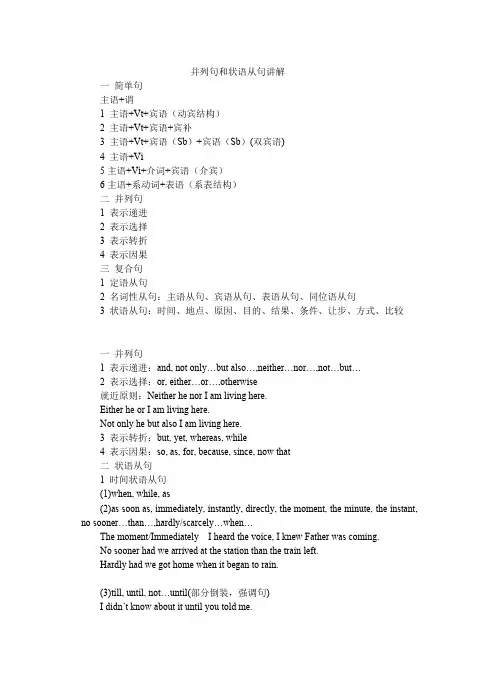
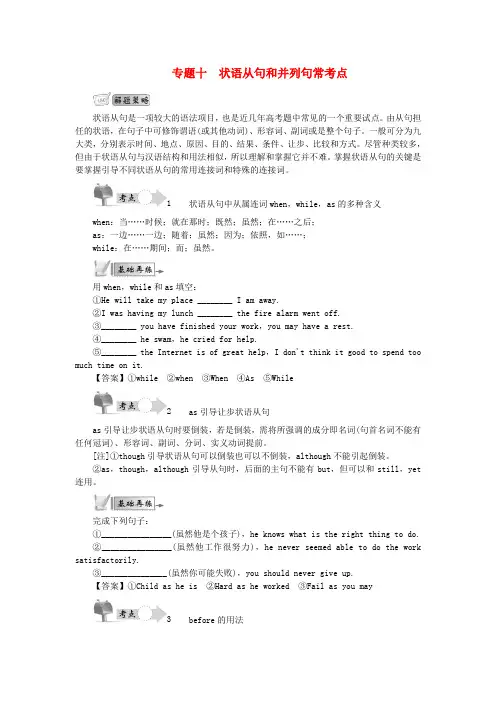
专题十状语从句和并列句常考点状语从句是一项较大的语法项目,也是近几年高考题中常见的一个重要试点。
由从句担任的状语,在句子中可修饰谓语(或其他动词)、形容词、副词或是整个句子。
一般可分为九大类,分别表示时间、地点、原因、目的、结果、条件、让步、比较和方式。
尽管种类较多,但由于状语从句与汉语结构和用法相似,所以理解和掌握它并不难。
掌握状语从句的关键是要掌握引导不同状语从句的常用连接词和特殊的连接词。
1状语从句中从属连词when,while,as的多种含义when:当……时候;就在那时;既然;虽然;在……之后;as:一边……一边;随着;虽然;因为;依照,如……;while:在……期间;而;虽然。
用when,while和as填空:①He will take my place ________ I am away.②I was having my lunch ________ the fire alarm went off.③________ you have finished your work,you may have a rest.④________ he swam,he cried for help.⑤________ the Internet is of great help,I don't think it good to spend too much time on it.【答案】①while②when③When④As⑤While2as引导让步状语从句as引导让步状语从句时要倒装,若是倒装,需将所强调的成分即名词(句首名词不能有任何冠词)、形容词、副词、分词、实义动词提前。
[注]①though引导状语从句可以倒装也可以不倒装,although不能引起倒装。
②as,though,although引导从句时,后面的主句不能有but,但可以和still,yet 连用。
完成下列句子:①________________(虽然他是个孩子),he knows what is the right thing to do.②________________(虽然他工作很努力),he never seemed able to do the work satisfactorily.③_______________(虽然你可能失败),you should never give up.【答案】①Child as he is②Hard as he worked③Fail as you may3before的用法注意判断before在状语从句中的含义:才;就;趁……没有;还没来得及;宁可……也不;不知不觉。
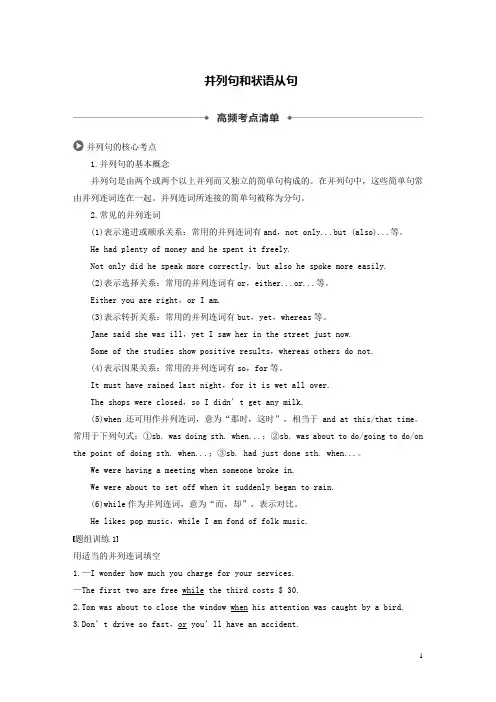
并列句和状语从句并列句的核心考点1.并列句的基本概念并列句是由两个或两个以上并列而又独立的简单句构成的。
在并列句中,这些简单句常由并列连词连在一起。
并列连词所连接的简单句被称为分句。
2.常见的并列连词(1)表示递进或顺承关系:常用的并列连词有and,not only...but (also)...等。
He had plenty of money and he spent it freely.Not only did he speak more correctly,but also he spoke more easily.(2)表示选择关系:常用的并列连词有or,either...or...等。
Either you are right,or I am.(3)表示转折关系:常用的并列连词有but,yet,whereas等。
Jane said she was ill,yet I saw her in the street just now.Some of the studies show positive results,whereas others do not.(4)表示因果关系:常用的并列连词有so,for等。
It must have rained last night,for it is wet all over.The shops were closed,so I didn’t get any milk.(5)when还可用作并列连词,意为“那时,这时”,相当于and at this/that time。
常用于下列句式:①sb. was doing sth. when...;②sb. was about to do/going to do/on the point of doing sth. when...;③sb. had just done sth. when...。
We were having a meeting when someone broke in.We were about to set off when it suddenly began to rain.(6)while作为并列连词,意为“而,却”,表示对比。
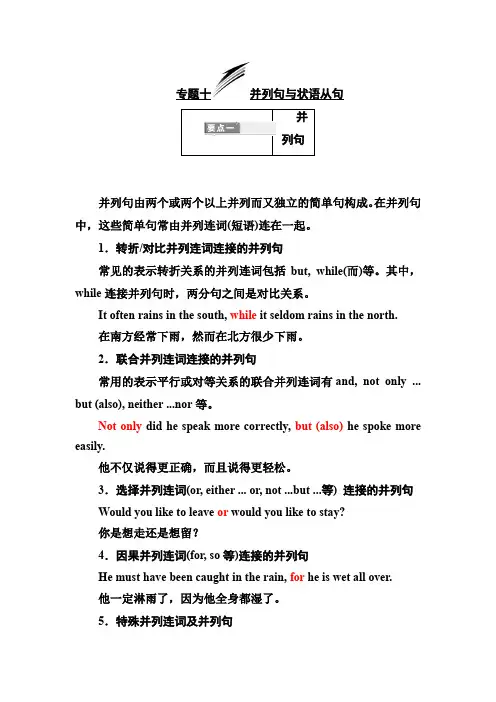
专题十并列句与状语从句并并列句由两个或两个以上并列而又独立的简单句构成。
在并列句中,这些简单句常由并列连词(短语)连在一起。
1.转折/对比并列连词连接的并列句常见的表示转折关系的并列连词包括but, while(而)等。
其中,while连接并列句时,两分句之间是对比关系。
It often rains in the south, while it seldom rains in the north.在南方经常下雨,然而在北方很少下雨。
2.联合并列连词连接的并列句常用的表示平行或对等关系的联合并列连词有and, not only ... but (also), neither ...nor等。
Not only did he speak more correctly, but (also) he spoke more easily.他不仅说得更正确,而且说得更轻松。
3.选择并列连词(or, either ... or, not ...but ...等) 连接的并列句Would you like to leave or would you like to stay?你是想走还是想留?4.因果并列连词(for, so等)连接的并列句He must have been caught in the rain, for he is wet all over.他一定淋雨了,因为他全身都湿了。
5.特殊并列连词及并列句(1)when可用于并列连词,意为“这时,那时”,相当于and at this/that time。
常用于下列句式:①be about to do sth. when ...“正要做某事,这时突然……”②be on the point of doing sth. when ...“正要做某事,这时突然……”③be doing sth. when ...“正在做某事,这时突然……”④had done sth. when ...“刚做了某事,这时突然……”He was about to go to school when a strong wind began to blow.他正要去上学,这时突然刮起了大风。
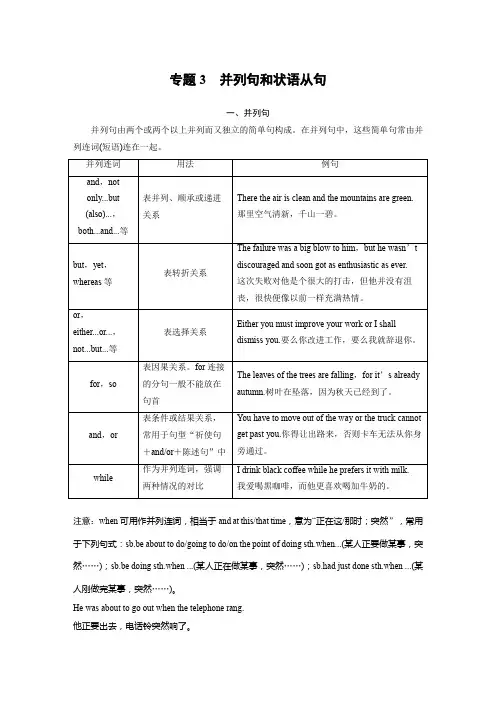
专题3并列句和状语从句一、并列句并列句由两个或两个以上并列而又独立的简单句构成。
在并列句中,这些简单句常由并列连词(短语)连在一起。
注意:when可用作并列连词,相当于and at this/that time,意为“正在这/那时;突然”,常用于下列句式:sb.be about to do/going to do/on the point of doing sth.when...(某人正要做某事,突然……);sb.be doing sth.when ...(某人正在做某事,突然……);sb.had just done sth.when ...(某人刚做完某事,突然……)。
He was about to go out when the telephone rang.他正要出去,电话铃突然响了。
He had just finished writing a report when the boss let him type a letter.他刚写完一篇报告,老板就让他打印一封信件。
单句语法填空1.At school,some students are active while some are shy,yet they can be good friends with one another.2.The other day I was doing some grocery shopping when a man walked toward a group of us at the checkout stand.3.Follow your doctor’s advice,or your cough will get worse.4.John plays basketball well,but/yet his favorite sport is badminton.二、状语从句考点一让步状语从句单句语法填空1.The athletes,especially the winners,should remain modest whatever rapid progress they have made.2.Much as/though I have traveled,I have never seen anyone who’s as capable as John. 3.Don’t trust him,no matter what he says.4.While/Although/Though I admit that there are problems,I don’t agree that they cannot be solved. 5.I’ll do it,even if/though it takes me all the afternoon.6.We’ll go on with the work,whether we can find the necessary tools or not.7.No matter how hard the work is,you’d better try to do it well.考点二时间状语从句单句语法填空1.Not until we succeed in letting wildlife live in peace can we smile in relief.2.Air pollution is getting more and more serious,so we must take action before it is too late. 3.He had no sooner finished his speech than the students started cheering.4.While watching TV,children do not merely absorb words and images.5.As he grew older,he became less active.考点三地点状语从句和条件状语从句单句语法填空1.Well,I’m working on a huge assignment and if I don’t do well,that will ruin my reputation as an excellent accountant!2.He will never make progress in math unless he really wants to learn it.3.Wherever she goes,there are crowds of people waiting to see her.4.Supposing/Suppose(suppose) that they refuse us,who else can we turn to for help?5.They agreed to lend us the car on condition that we returned it before the weekend.6.My parents don’t mind what job I do as long as I am happy.考点四其他状语从句单句语法填空1.If the guests are seated at the table,the hosts may serve the food,or it may be passed so that each person may help himself.2.Enjoying a fresh morning is important because/as it can set the mood for the rest of the day. 3.And he speaks so slowly and strangely that it takes patience to understand what he is saying. 4.They treat her as though/if she were their daughter.状语从句的省略1.时间、让步、方式、地点状语从句的省略如果状语从句的主语与主句的主语一致或从句的主语是it,而且状语从句的谓语中有be动词,可以将从句中的主语连同be动词一起省略。
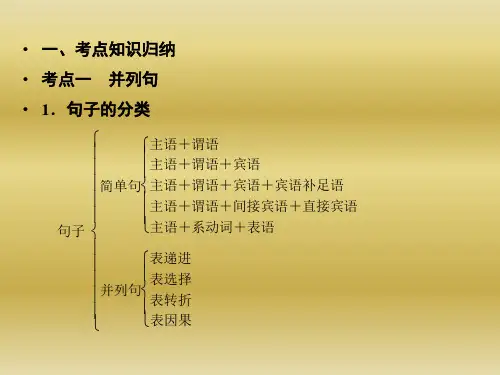
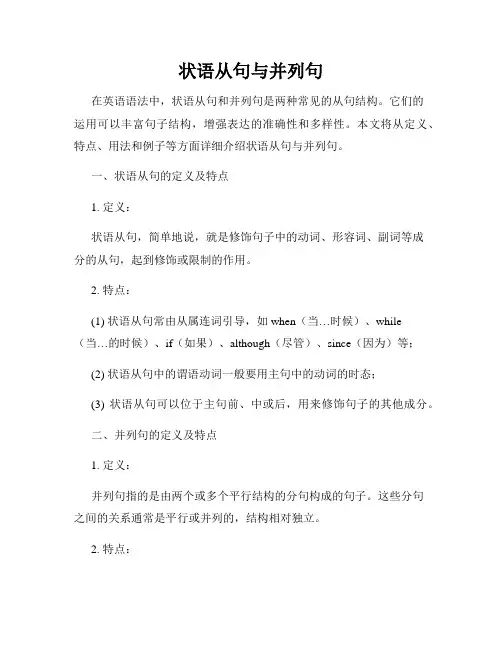
状语从句与并列句在英语语法中,状语从句和并列句是两种常见的从句结构。
它们的运用可以丰富句子结构,增强表达的准确性和多样性。
本文将从定义、特点、用法和例子等方面详细介绍状语从句与并列句。
一、状语从句的定义及特点1. 定义:状语从句,简单地说,就是修饰句子中的动词、形容词、副词等成分的从句,起到修饰或限制的作用。
2. 特点:(1) 状语从句常由从属连词引导,如when(当…时候)、while (当…的时候)、if(如果)、although(尽管)、since(因为)等;(2) 状语从句中的谓语动词一般要用主句中的动词的时态;(3) 状语从句可以位于主句前、中或后,用来修饰句子的其他成分。
二、并列句的定义及特点1. 定义:并列句指的是由两个或多个平行结构的分句构成的句子。
这些分句之间的关系通常是平行或并列的,结构相对独立。
2. 特点:(1) 并列句中的分句之间一般用逗号或并列连词连接,如and(和)、but(但是)、or(或者)等;(2) 并列句中的分句通常要保持结构平行,包括时态、语态、语气等方面的平行。
三、状语从句的用法及例子1. 时间状语从句:时间状语从句用来表示动作发生的时间,常由when、while、before、after、since等引导。
例子:- I will call you when I arrive at the airport.(当我到达机场时,我会给你打电话。
)- She was watching TV while her mother was cooking.(她妈妈在做饭的时候,她在看电视。
)2. 条件状语从句:条件状语从句用来表示主句动作发生的条件,常由if、unless、on condition that等引导。
例子:- If it rains tomorrow, we will stay at home.(如果明天下雨,我们会待在家里。
)- You can go outside unless it is too cold.(除非天气太冷,你可以出去玩。
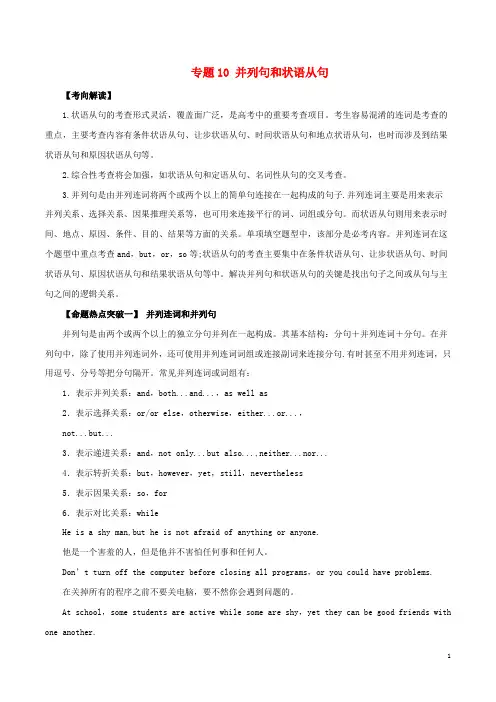
专题10 并列句和状语从句【考向解读】1.状语从句的考查形式灵活,覆盖面广泛,是高考中的重要考查项目。
考生容易混淆的连词是考查的重点,主要考查内容有条件状语从句、让步状语从句、时间状语从句和地点状语从句,也时而涉及到结果状语从句和原因状语从句等。
2.综合性考查将会加强,如状语从句和定语从句、名词性从句的交叉考查。
3.并列句是由并列连词将两个或两个以上的简单句连接在一起构成的句子.并列连词主要是用来表示并列关系、选择关系、因果推理关系等,也可用来连接平行的词、词组或分句。
而状语从句则用来表示时间、地点、原因、条件、目的、结果等方面的关系。
单项填空题型中,该部分是必考内容。
并列连词在这个题型中重点考查and,but,or,so等;状语从句的考查主要集中在条件状语从句、让步状语从句、时间状语从句、原因状语从句和结果状语从句等中。
解决并列句和状语从句的关键是找出句子之间或从句与主句之间的逻辑关系。
【命题热点突破一】并列连词和并列句并列句是由两个或两个以上的独立分句并列在一起构成。
其基本结构:分句+并列连词+分句。
在并列句中,除了使用并列连词外,还可使用并列连词词组或连接副词来连接分句.有时甚至不用并列连词,只用逗号、分号等把分句隔开。
常见并列连词或词组有:1.表示并列关系:and,both...and...,as well as2.表示选择关系:or/or else,otherwise,either...or...,not...but...3.表示递进关系:and,not only...but also...,neither...nor...4.表示转折关系:but,however,yet,still,nevertheless5.表示因果关系:so,for6.表示对比关系:whileHe is a shy man,but he is not afraid of anything or anyone.他是一个害羞的人,但是他并不害怕任何事和任何人。
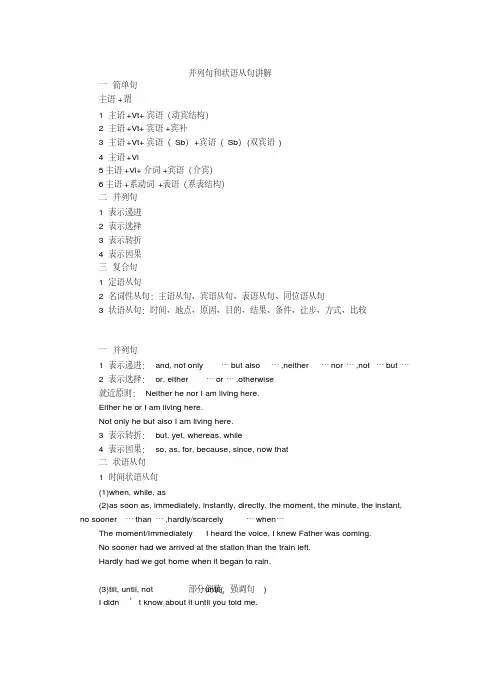
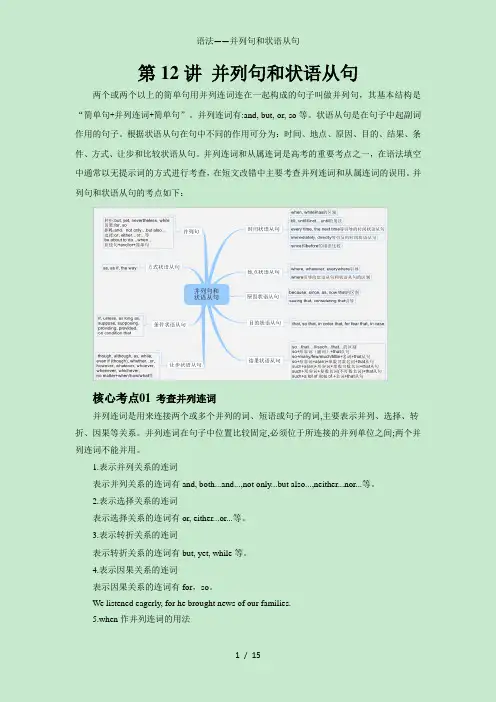
第12讲并列句和状语从句两个或两个以上的简单句用并列连词连在一起构成的句子叫做并列句,其基本结构是“简单句+并列连词+简单句”。
并列连词有:and, but, or, so等。
状语从句是在句子中起副词作用的句子。
根据状语从句在句中不同的作用可分为:时间、地点、原因、目的、结果、条件、方式、让步和比较状语从句。
并列连词和从属连词是高考的重要考点之一,在语法填空中通常以无提示词的方式进行考查,在短文改错中主要考查并列连词和从属连词的误用。
并列句和状语从句的考点如下:核心考点01考查并列连词并列连词是用来连接两个或多个并列的词、短语或句子的词,主要表示并列、选择、转折、因果等关系。
并列连词在句子中位置比较固定,必须位于所连接的并列单位之间;两个并列连词不能并用。
1.表示并列关系的连词表示并列关系的连词有and, both...and...,not only...but also...,neither...nor...等。
2.表示选择关系的连词表示选择关系的连词有or, either...or...等。
3.表示转折关系的连词表示转折关系的连词有but, yet, while等。
4.表示因果关系的连词表示因果关系的连词有for,so。
We listened eagerly, for he brought news of our families.5.when作并列连词的用法when除了作从属连词,引导时间状语从句外,还可作并列连词,其意义为“这时,那时”,相当于and at this/that time。
常用于下列句式:①sb. was doing sth. when...②sb. was about to/going to do sth. when...③sb. was on the point of doing sth. when...④sb. had just done sth. when...。
如:We were having a meeting when someone broke in.我们正在开会,这时有人闯了进来。
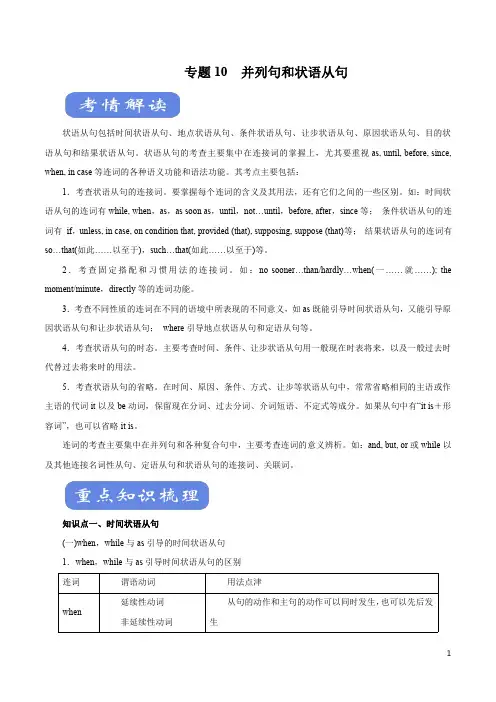
考点分布备考指南并列连词的基本用法在理解的基础上掌握并列句和状语从句的概念及分类,明确状语从句在语法填空、短文改错中的考查方式和重难点,并能够在遇到一个句子的时候准确分析和判定,提高长难句分析能力,加深对文章的理解。
状语从句基本引导词的用法as,since,while 的不同用法总结。
词性转化与固定搭配 句子结构分析与文章理解理解并分析文章中出现的从句。
专题解读知识图谱并列句与状语从句deep adj.深的breath n.呼吸count v.数mark n.分数;标志v.打分;做标记experience n.&v.经验(不可数);经历(可数)competition n.竞争;竞赛take off ①起飞;②脱下(反义)put onwonderful adj.绝妙的;了不起的kind n.种类adj.好心的abroad adv. 在(到)国外entertainment n.娱乐time n.次数(可数),时光(不可数)latest adj.最近的;最新的discover v.发现environment n.环境grow n.&v.生长;种植;变得universal adj.宇宙的,普遍的,通用的light n.光线;电灯adj.轻的,少的alone adj.孤单的;孤独的(作表语)cost (cost,cost) v.价钱为;花费知识清单必备词汇语法详解之并列句由并列连词将两个或两个以上平等关系的简单句连接在一起构成的句子叫并列句。
其结构是:简单句+并列连词+简单句一、并列关系常用的连词有and(同,和), when(=and just at this time就在这时,然后), not only…but (also)…(不仅……而且……), neither…nor…(既不……也不……)等。
如:He helps me and I help him.他帮我,我帮他。
He not only gave us a lot of advice, but also helped us to study English. 他不仅给我们出很多建议并且还帮助我学英语。
专题3并列句和状语从句一、并列句并列句由两个或两个以上并列而又独立的简单句构成。
在并列句中,这些简单句常由并列连词(短语)连在一起。
注意:when可用作并列连词,相当于and at this/that time,意为“正在这/那时;突然”,常用于下列句式:sb.be about to do/going to do/on the point of doing sth.when...(某人正要做某事,突然……);sb.be doing sth.when ...(某人正在做某事,突然……);sb.had just done sth.when ...(某人刚做完某事,突然……)。
He was about to go out when the telephone rang.他正要出去,电话铃突然响了。
He had just finished writing a report when the boss let him type a letter.他刚写完一篇报告,老板就让他打印一封信件。
单句语法填空1.At school,some students are active while some are shy,yet they can be good friends with one another.2.The other day I was doing some grocery shopping when a man walked toward a group of us at the checkout stand.3.Follow your doctor’s advice,or your cough will get worse.4.John plays basketball well,but/yet his favorite sport is badminton.二、状语从句考点一让步状语从句单句语法填空1.The athletes,especially the winners,should remain modest whatever rapid progress they have made.2.Much as/though I have traveled,I have never seen anyone who’s as capable as John. 3.Don’t trust him,no matter what he says.4.While/Although/Though I admit that there are problems,I don’t agree that they cannot be solved. 5.I’ll do it,even if/though it takes me all the afternoon.6.We’ll go on with the work,whether we can find the necessary tools or not.7.No matter how hard the work is,you’d better try to do it well.考点二时间状语从句单句语法填空1.Not until we succeed in letting wildlife live in peace can we smile in relief.2.Air pollution is getting more and more serious,so we must take action before it is too late. 3.He had no sooner finished his speech than the students started cheering.4.While watching TV,children do not merely absorb words and images.5.As he grew older,he became less active.。
状语从句与并列句状语从句(Adverbial Clause)和并列句(Compound Sentence)是语法中的两种常见句子结构。
它们不仅具有不同的特点,而且在句子中扮演了不同的语法角色。
本文将详细介绍状语从句和并列句的定义、特点和使用方法。
状语从句的特点状语从句是一个从属从句,它用来修饰主句中的动词、形容词或副词,并提供了更多的背景信息或条件。
状语从句通常由连词引导,比如when(当),while(当...时),if(如果),although(尽管)等。
下面是一些例句:1. When I arrived home, it started to rain.(当我到家的时候,开始下雨。
)2. Although she was tired, she continued working.(尽管她很累,她还是继续工作。
)3. If you study hard, you will pass the exam.(如果你努力学习,你会通过考试。
)可以看出,这些状语从句提供了额外的信息,使得整个句子更加完整、具体。
并列句的特点并列句是由两个或多个独立的子句组成的句子,这些子句平等地并列在一起,通过逗号、分号或者连词来连接。
并列句的结构如下:[独立子句1],[连词] [独立子句2]。
常见的并列连词有and(和)、but(但是)、or(或者)等。
下面是一些例句:1. I like playing basketball, and my sister likes playing tennis.(我喜欢打篮球,我姐姐喜欢打网球。
)2. It was raining heavily; therefore, we decided to stay at home.(雨下得很大,所以我们决定呆在家里。
)3. You can either come with us, or you can stay here.(你可以跟我们一起去,也可以留在这里。
专题10 并列句和状语从句状语从句包括时间状语从句、地点状语从句、条件状语从句、让步状语从句、原因状语从句、目的状语从句和结果状语从句。
状语从句的考查主要集中在连接词的掌握上,尤其要重视as, until, before, since, when, in case等连词的各种语义功能和语法功能。
其考点主要包括:1.考查状语从句的连接词。
要掌握每个连词的含义及其用法,还有它们之间的一些区别。
如:时间状语从句的连词有while, when,as,as soon as,until,not…until,before, after,since等;条件状语从句的连词有if,unless, in case, on condition that, provided (that), supposing, suppose (that)等;结果状语从句的连词有so…that(如此……以至于),such…that(如此……以至于)等。
2.考查固定搭配和习惯用法的连接词。
如:no sooner…than/hardly…when(一……就……); the moment/minute,directly等的连词功能。
3.考查不同性质的连词在不同的语境中所表现的不同意义,如as既能引导时间状语从句,又能引导原因状语从句和让步状语从句;where引导地点状语从句和定语从句等。
4.考查状语从句的时态。
主要考查时间、条件、让步状语从句用一般现在时表将来,以及一般过去时代替过去将来时的用法。
5.考查状语从句的省略。
在时间、原因、条件、方式、让步等状语从句中,常常省略相同的主语或作主语的代词it以及be动词,保留现在分词、过去分词、介词短语、不定式等成分。
如果从句中有“it is+形容词”,也可以省略it is。
连词的考查主要集中在并列句和各种复合句中,主要考查连词的意义辨析。
如:and, but, or或while以及其他连接名词性从句、定语从句和状语从句的连接词、关联词。
一、并列句1、句子的分类简单句并列句复合句作用/结构①主语+谓语②主语+谓语+宾语③主语+谓语+宾语+宾语补足语④主语+谓语+间宾+直宾⑤主语+系动词+表语①表递进②表选择③表转折④表因果⑤其他①形容词性从句(定语从句)②名词性从句:主语从句,宾语从句,表语从句,同位语从句③副词性从句(状语从句)2、并列句的基本概念并列句由两个或两个以上并列而又独立的简单句构成。
在并列句中,这些简单句常由并列连词连在一起。
并列连词所连接的简单句被称为分句。
3、常见的并列句①表递进关系。
常用的并列连词有:and, not only…but (also)…, neither…nor…, not…but…等。
如:Not only did he speak more correctly, but (also) he spoke more easily.②表选择关系。
常用的并列连词有:or, either…or…, otherwise等。
如:Either you are right ,orI am.③表转折关系。
常用的并列连词有but, yet, while等。
如:Lucy said she was ill,yet she insists on studying hard.④说明因果关系。
常用的并列连词有:so, for。
如:It must have rained last night for it is wet all over.⑤while作为并列连词,意为“而,却”,表示对比。
如:He likes pop music, while I am fond of folk music.二、时间状语从句1、when,while和as①when既可引导一个持续动作,也可引导一个短暂动作,可用于主句动作和从句动作同时发生,也可用于从句动作先于主句动作发生。
如:When I lived there,I used to go to the seashore on Sundays.(持续动作)When the film ended,the people went back.(短暂动作)当when引导的时间状语从句为系表结构,而且其主语和主句的主语一致,其表语又是一个名词时,就可以用由as引导的省略句来代替when引导的从句。
并列句与状语从句讲解连词是一种虚词,不能在句子中单独作句子成分,在句子中只起连接词与词、短语与短语、句子与句子以及从句的作用;一、并列句与连词连接同一语法类型的词、短语或句子1. 并列连词的分类并列连词按其作用可分为表示转折对比、因果、选择和并列四大类;1 表示转折的并列连词1.but但是,可连接两个句子,用逗号隔开;也可以放在句首2.yet 然而,尽管如此,连接两个句子,用逗号隔开;也可以放在句首The car is old,yet it is in good condition.注:yet也常放在完成时句尾表示还没有,此时不是连词,注意区分;3.while 而,可是,表示转折或对比,不用加逗号Lily likes go to school by bus while linda likes go to school by bike.4.however 然而,但是,一般位于句首,单个使用后加逗号阅读完型中常见到表转折;它们连接两个意思不同,阅读中遇到要注意;2 表示因果的并列连词表示因果的并列连词有:1.for 因为①由并列连词for 引导的分句常置于句子后部,而且常用逗号与前面的分句隔开;②for 分句主要是对前一分句补充说明理由或推断原因;③for 分句不能用来回答why 问句;She can’t go to school , for she is ill in bed.2.so 所以可以连接两个句子,中间有时用逗号隔开;也可以放在一个句子的句首;例:The shop doesn't open until 11 a.m. , so we should go there later..3.therefore 因此,用法和however类似,但词义不一样3 表示选择的并列连词表示选择的并列连词有:or 或者,either…or 不是……就是……,或者……或者……注①or用在祈使句中,意为“否则”,Hurry up, or you’ll be late. 快点,否则你就会迟到了;②or用在否定句中表示并列关系;They never dance or sing. 他们从不跳舞,也不唱歌;③either…or…连接主语时,谓语动词就近原则;4 表示并列关系的连词连接主语时注意谓语表示联合关系的连词有:1.and 和,而且 and ①用在肯定句中连接并列的成分,表示“和,而且”;②用在祈使句中,意为“那么”Study hard, and you will succeed. 努力学习,你就会取得成功;2.both…and…既……又,两者都谓语动词用复数Both you and he are right.3.as well as 也注谓语动词应与as well as 前面的主语在人称、数上保持一致;I as well as he am a doctor. 我和他一样,也是医生;4.not only…but also不但……而且……它连接主语时,谓语动词就近原则;Not only I but also students are tired of take the examination.5.neither…nor…既不……也不……它们用来连接两个并列关系的词、短语或分句;它连接主语时,谓语动词就近原则.Neither you nor she has ever gone the USA. 你从来没去过那,她也没去过;注:1.祈使句中and 表示那么,or表示否则2.谓语就近原则there be,either…or…,neither…nor…,not only…but also二、状语从句与连词1 引导时间状语从句的连词:时间状语从句服从主将从现Before把我们说过的例句写下来让他们填, after, when/while/as, since自从,用于完成时+since+过去时 ,not…until, as soon as一;;就;; 等;①when和while用法区别:while:She came in 点性while I was doing延续性my homework.我正在写作业的时候她进来了;When: I was doing my homework when she came in.我正在写作业,这时他进来了;②not…until,前加点性动词;肯定句时用延续性动词③as soon as 的主将从现I’ll tell her as soon as I see her. 我一见到她就告诉她;2 引导条件状语从句的连词:条件状语从句服从主将从现①if, 如果其引导的条件状语从句表示的前提或条件可以实现或正在进行,从句用现在完成时或进行时;I will give you a good price if you are thinking of buying it.③as long as, You’ll pass the exam as long as you work harder.④unless等; You’ll fail in the exam unless you work harder.⑤祈使句+and/or+陈述句意义上相当于条件状语从句3 引导原因状语从句的连词:because, as, since, for等;注意:如果原因是人们已经知道的事实,用since引导,有既然的意思4 引导目的状语从句的连词:①so that:He put on his glasses so that he could see it clearly.②in order that :1.与so as to 用法相同2.注意它与in order to的区别5 引导结果状语从句的词:such…that, so…that,She is so lovely a girl that we all like her.She is such a lovely girl that we all like her.注:区别当名词前有many或much修饰时,用so而不用such so much time6 引导地点状语从句的连词:where, wherever等;eg:Sit wherever you like. 请随便坐;7 引导让步状语从句的连词:though一般位于句中, although一般位于句首, even if,whatever, wherever, whenever等;Although he was tired, he kept on working. 虽然他很累,但仍继续工作;8 引导比较状语从句的连词: than, as…as, more…than…, the+比较级,the+比较级等;He doesn’t play half as well as his sister. 他演奏的水平不及他姐姐的一半;Our city is smaller than that one. 我们的城市比那个城市小;。
专题十状语从句和并列句常考点状语从句是一项较大的语法项目,也是近几年高考题中常见的一个重要试点。
由从句担任的状语,在句子中可修饰谓语(或其他动词)、形容词、副词或是整个句子。
一般可分为九大类,分别表示时间、地点、原因、目的、结果、条件、让步、比较和方式。
尽管种类较多,但由于状语从句与汉语结构和用法相似,所以理解和掌握它并不难。
掌握状语从句的关键是要掌握引导不同状语从句的常用连接词和特殊的连接词。
1状语从句中从属连词when,while,as的多种含义when:当……时候;就在那时;既然;虽然;在……之后;as:一边……一边;随着;虽然;因为;依照,如……;while:在……期间;而;虽然。
用when,while和as填空:①He will take my place ________ I am away.②I was having my lunch ________ the fire alarm went off.③________ you have finished your work,you may have a rest.④________ he swam,he cried for help.⑤________ the Internet is of great help,I don't think it good to spend too much time on it.2as引导让步状语从句as引导让步状语从句时要倒装,若是倒装,需将所强调的成分即名词(句首名词不能有任何冠词)、形容词、副词、分词、实义动词提前。
[注]①though引导状语从句可以倒装也可以不倒装,although不能引起倒装。
②as,though,although引导从句时,后面的主句不能有but,但可以和still,yet连用。
完成下列句子:①________________(虽然他是个孩子),he knows what is the right thing to do.②________________(虽然他工作很努力),he never seemed able to do the work satisfactorily.③_______________(虽然你可能失败),you should never give up.3before的用法注意判断before在状语从句中的含义:才;就;趁……没有;还没来得及;宁可……也不;不知不觉。
1. 判断下列各句中before的含义:()①We had sailed four days and four nights before we saw land.()②We hadn't run a mile before he felt tired.()③Please write it down before you forget it.()④Before I could get in a word,he had measured me.()⑤She would die before she'd give in.()⑥Three months went by before we knew it.2. 区别以下句型:用before,that,since,when填空:①It's three days ________ he returned home.②It was three days________ he returned home.③It will be three days________ he returns home.④It was three days later ________ he returned home.⑤It was three o'clock ________ he returned.[注]解答此类题目关键有三点:首先要确定是不是强调句,当我们把it is/was以及连接词去掉时,剩余部分若能构成一个完整的句子,就是强调句,这时连词用that;否则,就要考虑它的句式特点。
其次要看是时间段还是时间点。
再次是连接词前后的时态。
当确定为时间段时,连接词前后时态不一致,用since;时态一致,用before;当确定为时间点时,强调句就用that,否则就用when。
4where引导的定语从句和状语从句的区别和联系where引导定语从句时,相当于in/at/to which;where引导状语从句时,相当于in/at/to the place where...如:Please make a mark in the place where you have a question.(定语从句)Please make a mark where you have a question.(状语从句)①He lives in the quiet small village ________ I worked ten years ago.②He lives in ________ is called the Fairy Land Outside of the World.=He lives in the place ________ is called the Fairy Land Outside of the World.③—Mum,what did your doctor say?—He advised me to live ________ the air is fresher.A. in whereB. in whichC. the place whereD. where④________ others are weak,he is strong.A. WhereB. In the placeC. WhichD. While5unless的用法unless意为“除非;如果不”,相当于if...not。
①Most birds find it safe to sleep in the trees,but _____ they have eggs or young chicks,they don't use a nest.A. whyB. howC. unlessD. where②You must keep on working in the evening,________ you are sure you can finish the task in time.A. asB. ifC. whenD. unless③We won't keep winning games ________ we keep playing well.A. becauseB. unlessC. whenD. while④In time of serious accidents,_--we know some basic things about first aid,we can save lives.A. whetherB. untilC. ifD. unless6so...that...和such...that...引导结果状语从句的区别①so+形容词/副词+that...so+形容词+a(n)+名词+that...②such+a(n)+形容词+名词+that...such+形容词+不可数名词/可数名词的复数+that...[注]so/such...that...放在句首时要倒装。
完成下列句子:①He is such a good teacher that we all respect him.=He is ________________ that we all respect him.=So ________________ that we all respect him.=Such ________________ that we all respect him.②He made ________ rapid progress that the teacher praised him.=He made ________ much progress that the teacher praised him.注意句型:①表示目的状语的几种表达:He got up early to catch the early bus.=He got up early in order to catch the early bus.=He got up early so as to catch the early bus.=He got up early so that he could catch the early bus.=He got up early in order that he could catch the early bus.②His humour was such as to make us all laugh.=He was so humourous as to make us all laugh.7“一……就……”的表达法“一……就……”的表达法有:as soon as,hardly/scarcely...when...,no sooner...than...,the moment/minute/second/instant,immediately/instantly/directly,on/upon+n./doing。
完成下列句子:他一到达车站,汽车就发动了。
__________(连词) he arrived at the station,the bus started.=________(连词) had he arrived at the station when the bus started.=________(连词) had he arrived at the station than the bus started.=________(副词) he arrived at the station,the bus started.=________(名词) he arrived at the station,the bus started.=________(介词) his arrival at the station,the bus started.8注意倍数的表达倍数放在形容词或副词的原级、比较级或名词前。
如:①This river is three times longer than that one.This river is three times as long as that one.This river is three times the length of that one.②I have twice as many books as he has.I have twice as much money as he has.完成下列句子:①这个房间是那个房间的两倍大。